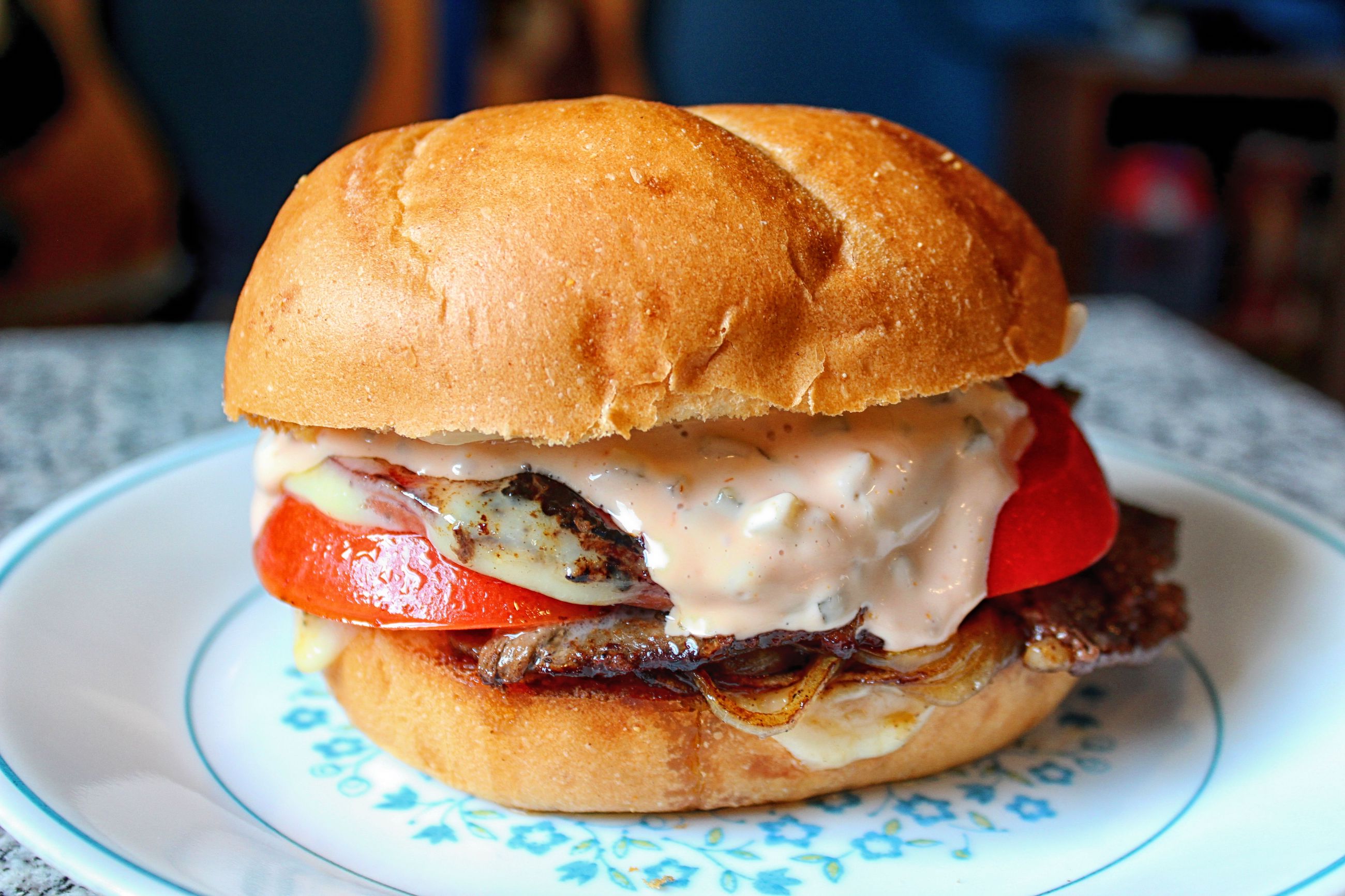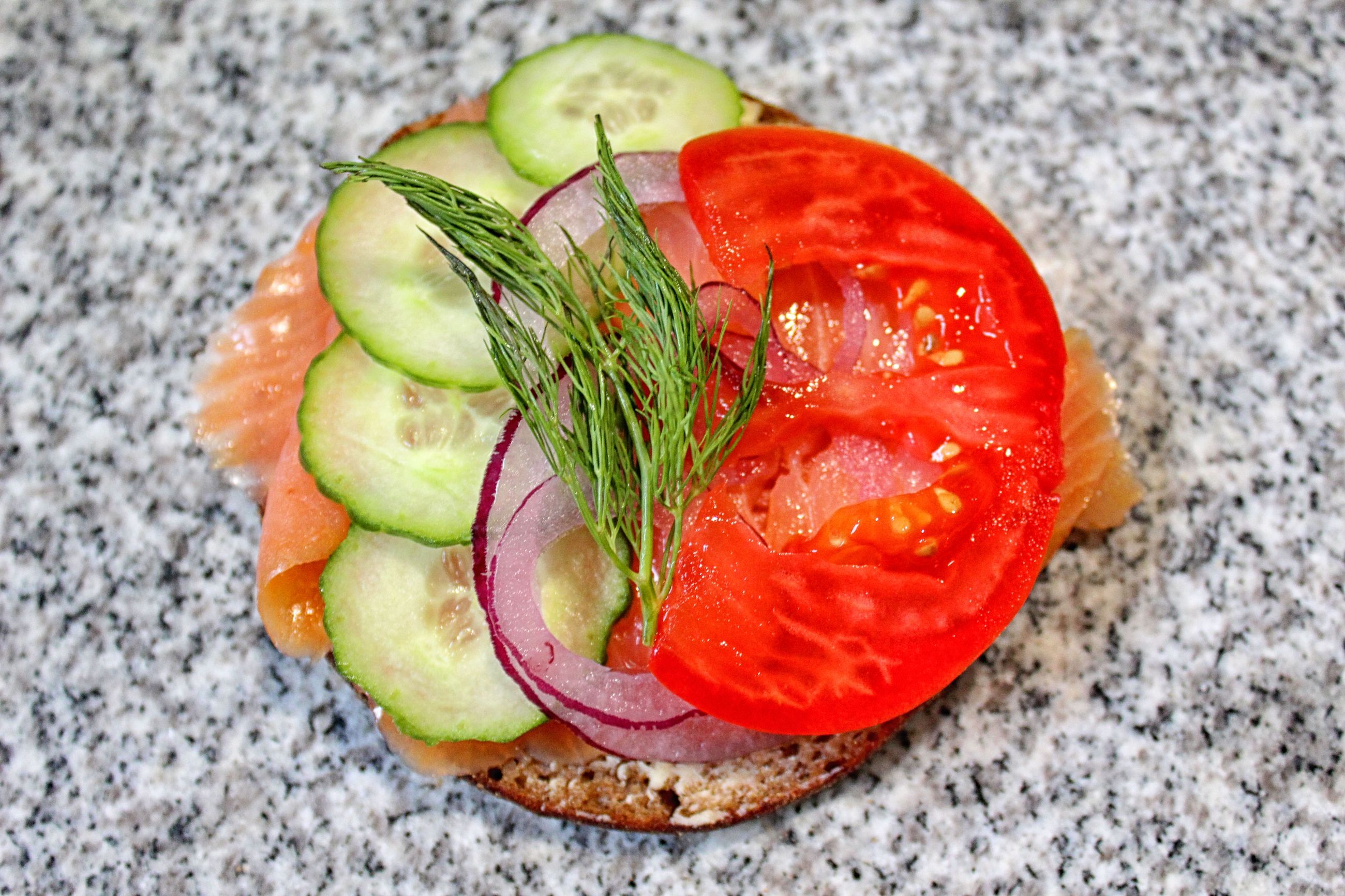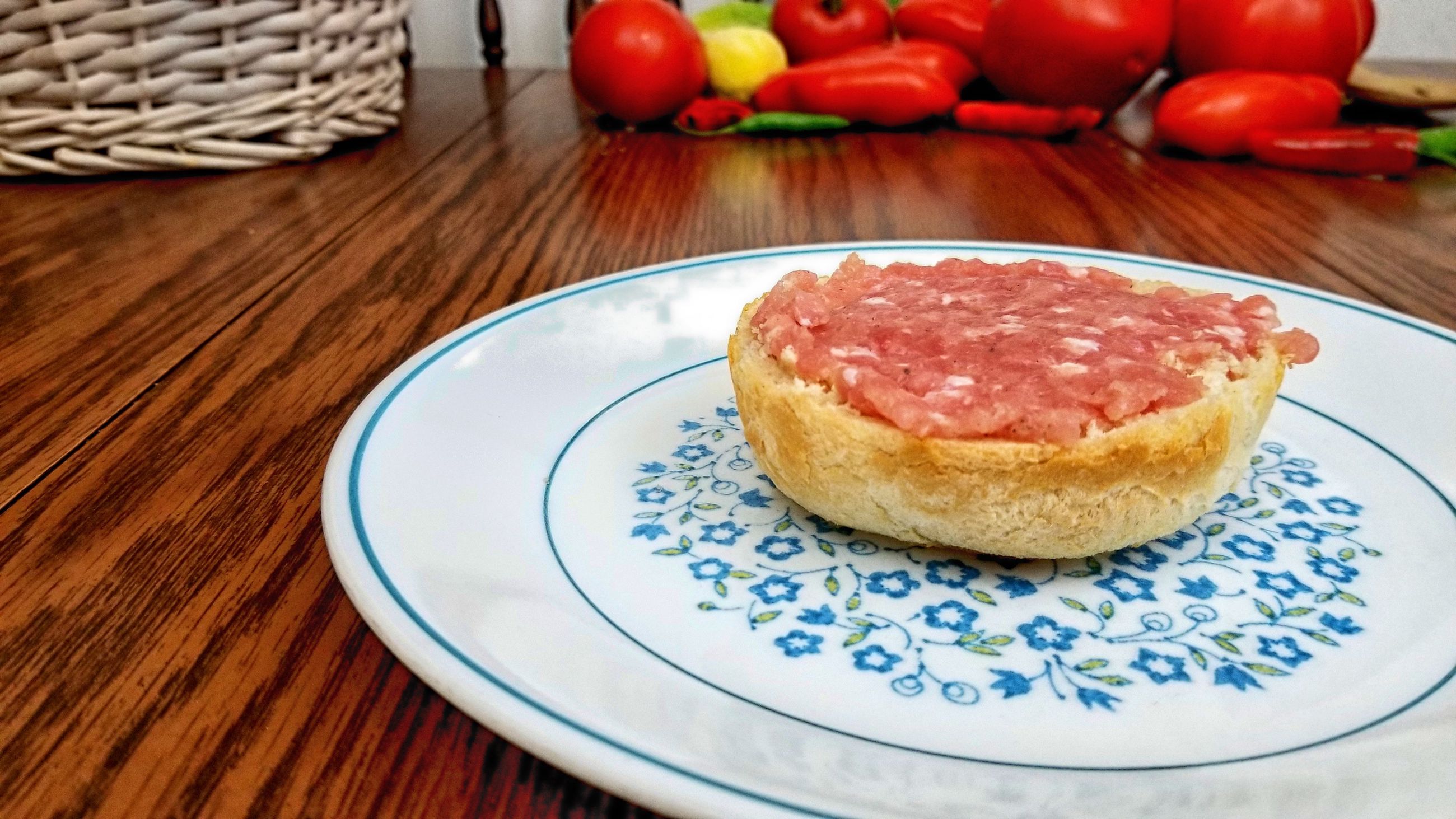The Princess and the Cheese: Bulgarian Toast
Perhaps my most valuable asset in the past 10+ years of trying to learn about and recreate or at least taste every sandwich I can from around the world has been the Chicago metropolitan area. There are many, many cultures represented in a city this size, and once a particular population hits a critical density, the markets and restaurants to service their culture are not far behind. A content creator called “Bored in Chicago” who posts videos on Instagram and other apps has been attempting, mostly successfully, to eat food from every country around the world without ever leaving Chicagoland–the diversity of a city this large not only creates opportunities for culinary adventure, but allows those who live and work here to encounter people from many different ethnic, cultural, and national backgrounds.
So when I started to research the “Princess” sandwich, a type of topped toast commonly served as a breakfast snack in Bulgaria, I knew that I should have no issues finding the ingredients and resources I needed for it–Chicago, after all, has the largest number of Bulgarian immigrants of any community in the world. Still, I do like to get the inside story on cultural foods when I can, so I reached out to my friend Pavel. Pavel is a former coworker and native Bulgarian who has been living in the US for the past 20 years… but I’ll let him tell you about himself in his own words:
I am currently 37 years old and from a city called Kardzhali, located in the southern part of Bulgaria. We have two dams on each end of town and a river splitting it in two, so I grew up often going camping and fishing. I came to the US, to Chicago, when I was 17. Luckily, Chicago has a huge Bulgarian community, which helped me get acquainted to the new environment quickly. As you know, I am in the IT industry, since 2012, and believe or not I actually like it 🙂 though some days are exceptions. I’ve played sports all my life–I’ve always played soccer, but there was a time in my teen years when I played Badminton, even reaching 3rd place on the national level 15 years old and under. When I came here, I played a bit just for fun, and then switched to playing soccer again. We like to travel all over the place, to try new food, and explore new places. My 4 year old daughter Sophia is always part of the trip! 😀 She has been traveling since she was 6 months old.
Pavel is good people, among the friendliest guys I’ve ever worked with. I asked Pavel if he knew any good spots to try the Princess and he told me
Go to Balkanika or Mehanata. But if they have both Strandjanka and Princess, try both of them.
My Bulgarian friend Pavel, on where to find a Princess sandwich in the Chicago area.
So Mindy and I went to Restaurant Mehanata in Des Plaines, and we ordered both their Princess and their Strandjanka.


At Mehanata, “Princess” or Принцеса с яйца и сирене referred to a slice of good bread topped with a mixture of egg, feta, and kashkaval cheese, toasted and well-browned under a broiler, served on a plate with pickles and sliced tomato. Strandjanka or Странджанка on the other hand was a slice of the same bread, topped with seasoned ground meat–it seemed to be pork, or maybe a pork/beef mixture–with the meat grilled directly against the bread, served on the same plate with the same pickles and tomatoes. It was served with a small dish of seasoning on the side, which our waitress described as a combination of an herb she did not know the English name for (it turned out to be summer savory) with salt and paprika. I later learned this combination was called шарена сол in Bulgarian–Sharena sol, or colorful salt–and I alternated between sprinkling it on the meat directly, and using it to season the tomato slices I ate atop the meat.

Along with the toasts, we ordered a salad called Shopska consisting of chopped tomato, cucumber, green pepper, green onion, and Kalamata olives lightly dressed with vinegar and herbs and topped with an absolute mound of finely-shredded cheese, either feta or the similar cheese called sirene. Mindy requested a pork shish kebab (Свинско шишче), which was grilled to a dark brown but still juicy and well-seasoned, served with a wedge of lemon, a leaf of lettuce, and a couple of cherry tomatoes. I also requested an espresso with a side of steamed milk and, when recommended, a glass of Ayran–a thin salty/sour yogurt-based drink, not pictured below–to have alongside the Strandjanka.



The toasts were great–Mindy preferred the Princess with egg and cheese, the slightly sharp flavor of the kashkaval, milder than cheddar but stronger than, say, Monterey Jack, was a bit lost against the briny and slightly sour feta, but both combined with the beaten egg into an omelet-like topping, adhering to and infusing with the crisp surface of the bread, attractively browned under the salamander’s fire. I enjoyed the meat topping as well, its firm sausagey texture also blending into the toast’s edges, only lightly seasoned but not bland, lean and scored by the grill but not overcooked.
Pavel clarified that Princess and Strandjanka are essentially regional names or variants of what is at heart a singular snack, a category of topped toasts that most of Bulgaria simply calls Princesses–Strandjanka is a term for the meat style of Princess that is particular to the Bourgas area of eastern Bulgaria. He also sent along a photo of his preferred version, with ham and melted cheese.

“So some regions in Bulgaria call the one with the ground meat Strandjanka…where I am we call it Princess, just with meat. You can do it with ground meat, with egg and feta mix, or you can also do with cheese and ham for example. “
What kind of cheese? I asked
“Bulgarian yellow cheese… kashkaval.”
Do you put anything on your princess sandwiches? I have read that some people put ketchup or mayo or mustard or ljutenica on it.
“On the Strandjanka, yes you can put ljutenica. Not on the other types though. Ketchup can go on all except the one with cheese and eggs.”
Our waitress at Mehanata, who like Pavel was proud of her culture’s cuisine, seemed excited to have guests who were as interested in Bulgarian food as we were. After fielding a lot of our questions patiently, she pointed out to us that a few blocks from the restaurant there was a Bulgarian market called Malincho where we could get many of the items we’d been discussing with her. So it was that we came home with a loaf of Bulgarian bread, a light colored rye bread with a crusty exterior but soft crumb; a brick of Bulgarian kashkaval cheese made from goat’s milk; a large chunk of Bulgarian goat milk feta that I picked out of a vat of brine; and a bottle of a Bulgarian brandy called Rakia that doesn’t really feature into this article except in that, as Pavel pointed out to me, “Rakia goes with everything Bulgarian!”





In addition, I made my own homemade лютеница or ljutenica, a red pepper relish similar to the ajvar served in some other Balkan cuisines. I used red peppers (and half a yellow pepper), jalapenos, tomatoes, and half an onion that I roasted under the broiler and peeled, chopped roughly in a blender with a little salt and olive oil then reduced on the stove for 30-45 minutes. I also found a jar of ljutenica at a local market, though I believe it was a Macedonian brand rather than a Bulgarian one. Additionally, I made my own colorful salt with dry summer savory, sea salt, paprika, cumin, and garlic powder.




In my first pass, I made all three of the types of Princess Pavel mentioned. First I buttered each slice of bread lightly. Then I topped one slice with 2 pieces of ham-off-the-bone and shredded kashkaval; and another slice with a mixture of beaten eggs, crumbled chunks of feta cheese, and shredded kashkaval. For the Strandjanka I used a combination of ground pork and lean ground beef with some Sharena sol and enough beaten egg to make the mixture spreadable, then topped that with a bit more of the shredded kashkaval cheese.






These went under the broiler for 10-15 minutes, on a lower shelf, farther from the fire, so that the toppings would have time to cook before they burnt. Though I could have done a better job of spreading those toppings right out to the edges of the bread to keep the crust from getting quite so dark.





But even with that extra-brown crust, I liked all three of these styles. Ham and melted cheese on toast needs no excuse to exist–it is a snack I’ve enjoyed for decades independent of any interest in Bulgarian cuisine and needed no additional condiment, though some pickle or mustard would certainly not be amiss. The meat on my version of the Strandjanka shrunk away from the edges of the bread while cooking, causing that near-burnt crust, and the meat itself was somewhat uninteresting, needing more seasoning than I gave it. I tried it both with my homemade ljutenica and with some Sharena sol sprinkled on and both were vast improvements, the ljutenica very much like a medium salsa with a bit more bell pepper flavor than usual, spicy and savory but missing a bit of acidity that some vinegar might have fixed. The store-bought version of the ljutenica was both chunkier and more aggressively seasoned with vinegar and sugar than mine but less spicy, a sweet/sour pepper relish, red as a jewel, well-suited for dressing what was essentially a mildly-flavored sausage bread.




I tried the sharena sol on the egg-and-cheese Princess as well and it was good–but that version of this Bulgarian toast did not need improvement. Feta cheese is egg’s natural partner, briny and sharp and sour in ways that complement the mildly savory substance of the egg, and the kashkaval’s good melting qualities help glue the egg and feta to the toast. On subsequent tries I seasoned the meat with additional sharena sol and used egg to make it more spreadable, which allowed the meat to remain in place and protect the bread from burning.
I’d try making any of the different styles of Princess sandwich again. It is not a fancy or a complicated sandwich. But good bread and interesting cheese take it a long way.

I like sandwiches.
I like a lot of other things too but sandwiches are pretty great











Recent Comments